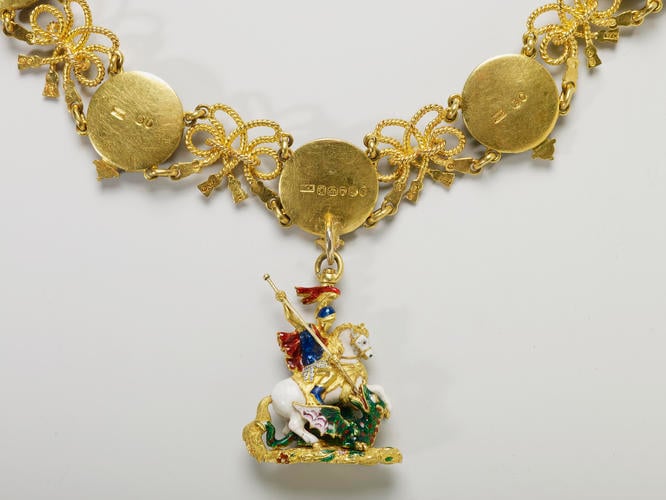-
1 of 253523 objects
Rundell, Bridge & Co
Garter collar and Great George 1837
Gold, enamel | RCIN 441376
Red Saloon, Kensington Palace








-
72 links of 36 double Tudor Roses, sixteen red behind, sixteen white behind all, surrounded by garter, gold on blue, alternating with 36 gold lovers' knots. Great George; St George free standing, in blue cuirass and helmet and red cloak and plume riding a white horse and attacking a green dragon with pink wings, St George has a gold lance and saddle.
Upon her accession to the throne Queen Victoria automatically became Sovereign of each of the British orders of chivalry: the Orders of the Garter, Thistle, St Patrick, Bath, and St Michael and St George. Queens Regnant from Mary Tudor onwards had only worn the Garter - although Queen Anne had refounded the Order of the Thistle in 1703. Suitable new insignia was thus needed for the new Queen, for whom the standard gold or gilt metal collars would have been too heavy (the standard Garter collar was 30oz of gold). The designs reflected three factors: the Queen’s diminutive stature, the décolleté fashion, and the prospect that the Queen might wear more than one collar at a time, a custom started by George IV and continued by William IV. A full set of collars in fitted mahogany cases was commissioned from Rundell, Bridge & Co. All the collars have lighter and smaller links than the standard pieces. In particular, the Garter collar is longer than the others to allow it to be worn from the upper arms rather than over the shoulders, and there is evidence that it was extended very shortly after its manufacture, from the standard length comprising twenty-four knots and twenty-four roses to thirty-six knots and thirty-six roses. However there is no obvious point at which the additional links were added as they all bear the same hallmarks.
In the manufacture of the Garter and the Bath collars - as well as the other collars of the suite - there are variations in the design of each piece from a standard investiture collar of the time. In the case of the Garter collar the roses are alternately red on white and white on red. This design follows the statute of the Order when the collar was instituted by Henry VIII in 1544, but no other collar following these designs is known to have existed. On the Bath collar, the badge hangs not from one of the crowns, as is usual, but from a white enamel knot. Similar variations affect the other collars of the suite.
According to the Ceremonial, the Queen was to have worn all four collars at her Coronation, but in the event she wore only the Garter collar. It was frequently depicted by artists, notably in the full-length portrait by Winterhalter of 1843. The Bath collar was worn at the investiture of Bath knights.
A volume of preparatory sketches for the collars by Rundell, Bridge & Co. was purchased for the Royal Library in 1950.
Struck with marks for London, 1837; maker’s mark WC, possibly for William Cooper; base of Great George engraved: RUNDELL, BRIDGE & CO Jewellers and Goldsmiths To The Queen
Text adapted from Victoria & Albert: Art & Love, London, 2010Provenance
Made for Queen Victoria, 1837
-
Creator(s)
Acquirer(s)
-
Medium and techniques
Gold, enamel
Other number(s)
Alternative title(s)
Order of the Garter. Queen Victoria's collar and Great George